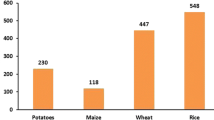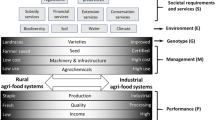
Overview
- Gathers a unique blend of contributions by internationally respected potato experts, providing both global and local perspectives and experience
- Delivers a fresh and cutting-edge perspective, updating its previous version published by Springer in 1992
- Written in a jargon-free language, making it appealing for a much broader readership than just researchers, graduate students or academics
- Firmly based on scientific evidence gathered through state of the art R&D activities and the contributions of renowned authors
Buy print copy
Tax calculation will be finalised at checkout
About this book
This book provides a fresh, updated and science-based perspective on the current status and prospects of the diverse array of topics related to the potato, and was written by distinguished scientists with hands-on global experience in research aspects related to potato. The potato is the third most important global food crop in terms of consumption. Being the only vegetatively propagated species among the world’s main five staple crops creates both issues and opportunities for the potato: on the one hand, this constrains the speed of its geographic expansion and its options for international commercialization and distribution when compared with commodity crops such as maize, wheat or rice. On the other, it provides an effective insulation against speculation and unforeseen spikes in commodity prices, since the potato does not represent a good traded on global markets. These two factors highlight the underappreciated and underrated role of the potato as a dependable nutrition security crop, one that can mitigate turmoil in world food supply and demand and political instability in some developing countries. Increasingly, the global role of the potato has expanded from a profitable crop in developing countries to a crop providing income and nutrition security in developing ones. This book will appeal to academics and students of crop sciences, but also policy makers and other stakeholders involved in the potato and its contribution to humankind’s food security.
Similar content being viewed by others
Keywords
Table of contents (14 chapters)
-
Front Matter
-
Food Security, Diets and Health
-
Front Matter
-
-
Genetic Resources, Genetics and Genetic Improvement
-
Front Matter
-
-
Seed Systems, Participatory Research and Gender
-
Front Matter
-
-
Back Matter
Reviews
Editors and Affiliations
About the editors
Dr. Oscar Ortiz is the Deputy Director-General for Research and Development and has worked at theInternational Potato Center for more than two decades. An agronomist by training, Dr. Ortiz received his BA from the Universidad Nacional de Cajamarca, Peru, his MSc on Agricultural Extension and Crop Production from the Universidad Nacional Agraria la Molina, and his PhD from Reading, UK. He led the CIP’s Integrated Crop Management Research Division and the Integrated Crop and systems Research Global Program until 2013, when he was appointed Deputy Director of Research for Regional Science Programs. Dr. Ortiz has spent a decade leading and managing interdisciplinary teams involving both the biophysical and social sciences. He has extensive experience in participatory research and training related to integrated insect and disease control; integrated crop management; agronomy and seed management; impact assessment of research and extension activities; and the use of agricultural knowledge and information systems for research and development. He has published extensively in peer-reviewedjournals, book chapters and conference proceedings.
Bibliographic Information
Book Title: The Potato Crop
Book Subtitle: Its Agricultural, Nutritional and Social Contribution to Humankind
Editors: Hugo Campos, Oscar Ortiz
DOI: https://doi.org/10.1007/978-3-030-28683-5
Publisher: Springer Cham
eBook Packages: Biomedical and Life Sciences, Biomedical and Life Sciences (R0)
Copyright Information: The Editor(s) (if applicable) and The Author(s) 2020
Hardcover ISBN: 978-3-030-28682-8Published: 16 December 2019
Softcover ISBN: 978-3-030-28685-9Published: 11 September 2020
eBook ISBN: 978-3-030-28683-5Published: 03 December 2019
Edition Number: 1
Number of Pages: XVII, 518
Number of Illustrations: 8 b/w illustrations, 91 illustrations in colour
Topics: Agriculture, Nutrition, Plant Breeding/Biotechnology, Food Science, Agricultural Economics



